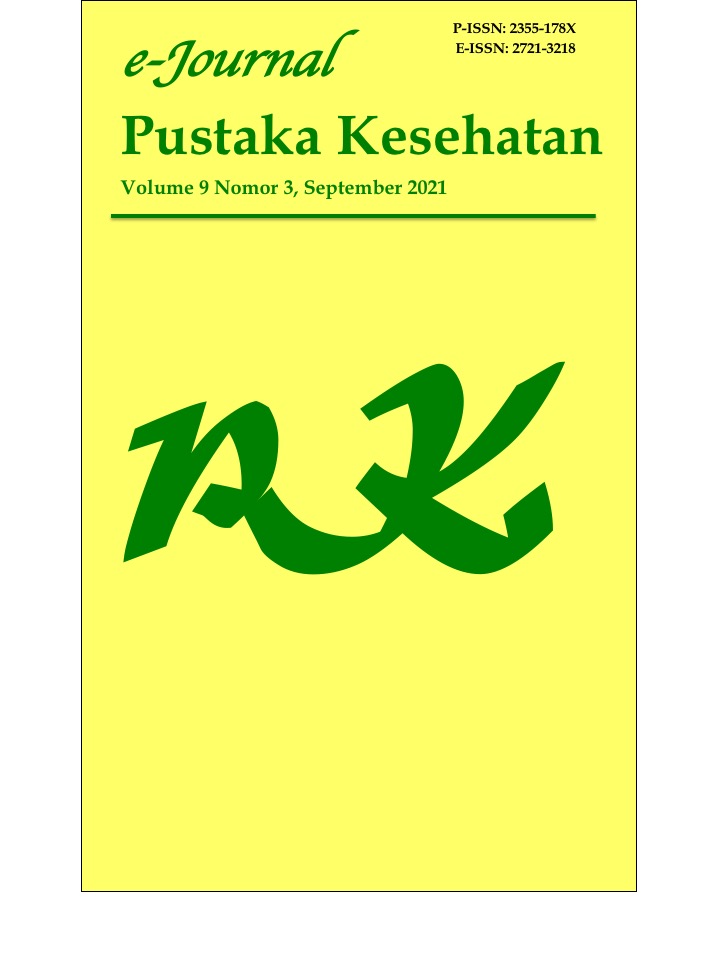Optimasi Tween dan Propilen Glikol dalam Self-Nanoemulsifying Drug Delivery System VCO-Minyak Daun Kemangi
DOI:
https://doi.org/10.19184/pk.v9i3.22582Keywords:
Basil leaf oil, SNEDDS, Antibacterial, Factorial DesignAbstract
Basil (Ocimum basilica) contains active compounds of essential oils that have volatile properties, so it will affect its antibacterial activity. SNEDDS was chosen as a delivery system to increase essential oil stability. The purpose of this study was to determine the effect of tween 80 concentration, propylene glycol, and their interactions in VCO on SNEDDS of basil leaf oil on response and to determine the antibacterial activity with optimum characteristics. Optimization of tween 80 and propylene glycol was conducted using the VCO oil phase with a factorial design method using design expert software 11 with the response used, namely% transmittance and emulsification time. Verification and characterization were carried out including organoleptic, pH, particle size, particle distribution, then tested for antibacterial activity. The results showed that an increase of tween 80 concentration and a decrease of propylene glycol would increase the transmittance value and decrease the emulsification time. There was no interaction effect between the two. Prediction software design expert 11 showed optimum formula with a clear yellow color appearance, the distinctive odor of basil oil, has an average pH of 6.81 ± 0.03, an average particle size of 19.7 ± 0.16 nm, a particle distribution with an average PDI average of 0.163 ± 0.05. The optimum formula with a concentration of 30 μl has activity against S. thypi with an average inhibition zone diameter of 17.21 ± 1.01 mm.
Downloads
References
[2] Saputra RK, Majid R, Bahar H. Hubungan pengetahuan, sikap dan kebiasaan makan dengan gejala demam thypoid pada mahasiswa Fakultas Kesehatan Masyarakat Universitas Halu oleo tahun 2017; Jurnal Ilmiah Mahasiswa Kesehatan Masyarakat. 2(6):1–7.
[3] Ochiai RL, Acosta CJ, Holiday MCD, Baiqing D, Bhattacharya SK, Agtini MD, et al. A study of typhoid fever in five Asian countries: disease burden and 44 implications for controls. Bull World Health Organ. 2008; 86: 260-268.
[4] Liang R, Xu S, Shoemaker CF, Li Y, Zhong F, Huang Q. Physical and Antimicrobial Properties of Peppermint Oil Nanoemulsions. Journal of Agricultural and Food Chemistry. 2012; 60(30): 7548–7555.
[5] Patel J, Patel A, Raval M, Sheth N. Formulation and development of a self-nanoemulsifying drug delivery system for telmisartan for oral drug delivery. International Journal of Pharmaceutical Investigation. 2011; 2(1): 9–16.
[6] Nasr A, Gardouh A, Ghorab M. Novel solid self-nanoemulsifying drug delivery system (s-snedds) for oral delivery of olmesartan medoxomil: design, formulation, pharmacokinetic and bioavailability evaluation. Pharmaceutics. 2016; 8(3); 2-29.
[7] Pratiwi L, Fudholi A, Martien R, Pramono S. Self-nanoemulsifying drug delivery system (snedds) for topical delivery of mangosteen peels (garcinia mangostana l.): formulation design and in vitro studies. Journal of Young Pharmacists. 2017; 9(3): 341–346.
[8] Ujilestari T, Martien R, Ariyadi B, Dono ND, Zuprizal. Self-nanoemulsifying drug delivery system (SNEDDS) of Amomum compactum essential oil: Design, formulation, and characterization. J App Pharm Sci, 2018; 8(06): 014-021.
[9] Savale SK. A review - self nanoemulsifying drug delivery system (snedds). International Journal of Research in Pharmaceutical and Nano Sciences, 2015; 4(6):385–397.
[10] Sugiyono. Metode Penelitian Pendidikan: Pendekatan Kuantitatif, Kualitatif, Dan R&D. Bandung: Alfabeta; 2016.
[11] Wulandari E, Alverina A, Martien R. SNEDDS (selfnanoemulsifying drug delivery system) formulation of β-carotene in olive oil (olea europaea). International Journal of Advanced Research. 2016; 4(11): 1031– 1043.
[12] Date AA, Desai N, Dixit R, Nagarsenker M. Self-nanoemulsifying drug delivery systems: formulation insights, applications and advances. Nanomedicine. 2010; 5(10): 1595–1616.
[13] Yuliani SH, Hartini M, Stephanie, Pudyastuti B, Istyastono EP. Perbandingan stabilitas fisis sediaan nanoemulsi minyak biji delima dengan fase minyak long-chain triglyceride dan medium-chain triglyceride. Tradit Med J. 2016; 21(2): 93-98.
[14] Patro SS, Chua HJ. Formulation and evaluation of solid-self nano emulsifying drug delivery system (s-snedds) for glibenclamide. World Journal of Pharmacy and Pharmaceutical Sciences. 2019; 8(1): 307–320.
[15] Susanto D, Sudrajat, Ruga R. Studi Kandungan Bahan Aktif Tumbuhan Meranti Merah (Shorea leprosula Miq) Sebagai Sumber Senyawa Antibakteri. Mulawarmnan Scientifie. 2012; 11(2): 181-190.
[16] Zukhruf NW. Aktivitas antibakteri kombinasi minyak atsiri kemangi (Ocimum basilicum L) dengan kloramfenikol dan gentamisin terhadap Salmonella typhii. Surakarta: Universitas Muhammadiyah Surakarta; 2014.
[17] Noriko N, Masduki A, Azhari R, Nufadianti G. Uji In Vitro Daya Anti Bakterial Virgin Coconut Oil (VCO) pada Salmonella typhi. Jurnal ALAZHAR Indonesia Seri Sains dan Teknologi. 2014; 2(3): 188-192.
Downloads
Published
Issue
Section
License
e-Journal Pustaka Kesehatan has CC-BY-SA or an equivalent license as the optimal license for the publication, distribution, use, and reuse of scholarly work. Authors who publish with this journal retain copyright and grant the journal right of first publication with the work simultaneously licensed under a Creative Commons Attribution-ShareAlike 4.0 International License that allows others to share the work with an acknowledgment of the work's authorship and initial publication in this journal.



